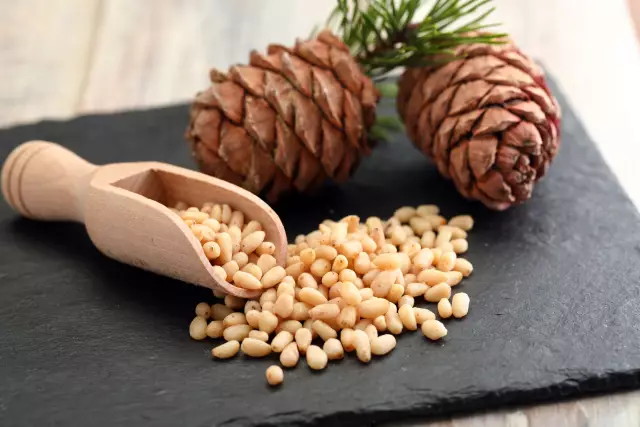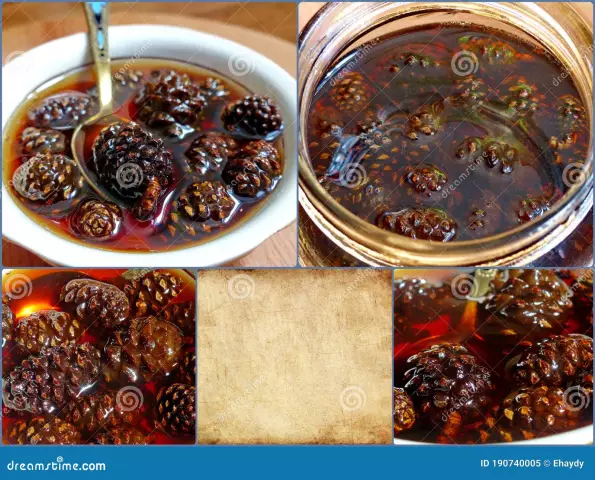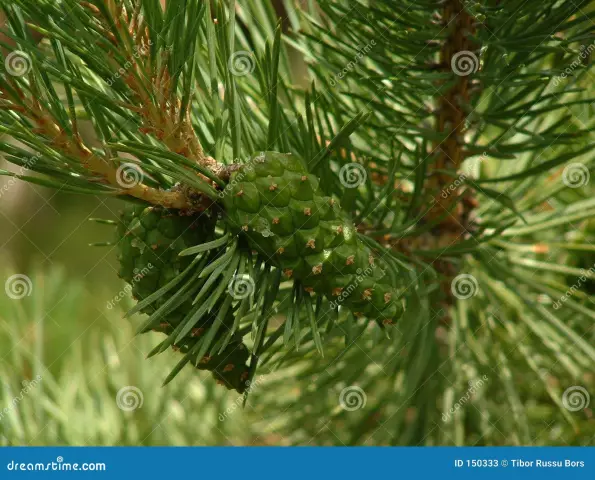- Author Rachel Wainwright [email protected].
- Public 2023-12-15 07:39.
- Last modified 2025-11-02 20:14.
Treatment with pine cones after a stroke: indications, contraindications, recipes
The content of the article:
- Why pine cones are useful
- Contraindications for use
- Pine cones treatment after stroke: recipes
- Overview of Stroke
- Video
Pine cones after a stroke are a folk remedy that is used in addition to the main treatment and rehabilitation of a patient after an acute cerebrovascular accident.

Pine cones contain substances that have a beneficial effect on the blood vessels of the brain
Stroke ranks first in the ranking of pathologies that most often lead to death. According to statistics, about 30% of patients die in the first year after suffering a stroke, approximately the same number of patients remain bedridden, and 10% of patients may have a second stroke. After suffering a severe stroke, working capacity can be fully maintained in about 20% of patients.
For this reason, prevention, as well as high-quality rehabilitation of the patient after a stroke, is of no small importance. Pine cones are popular traditional medicines used for this purpose.
Why pine cones are useful
The restoration of brain functions when using products made on the basis of pine cones is due to the beneficial substances that they contain. So, in pine cones, one of the types of tannins was found that have a positive effect on brain cells, which is able to prevent the death of neurons in patients after a stroke. Pine cones contain phytoncides, essential oils, and trace elements. Taking pine cones tincture after a stroke can prevent the development of paresis, paralysis, strengthen the walls of blood vessels, restore memory, coordination of movements and speech of the patient. In addition, this remedy has a positive effect on the cardiovascular system.
Among the indications for the use of drugs from pine cones, in addition to stroke, ischemic heart disease, heart attack, arterial hypertension, and some other diseases of the cardiovascular system are called. This tool is used to prevent the development of oncological processes in the body.
Contraindications for use
There is an opinion that traditional medicines, especially of plant origin, are absolutely safe. This is not true. Pine cone preparations, like any others, have contraindications for use. It is worth remembering that after a stroke, all procedures and remedies should be used only after consultation with the attending physician.
Pine cone tincture is contraindicated in patients with acute hepatitis, patients over 60 years old, with a tendency to allergies. The tool should be used with caution in kidney pathologies and during pregnancy.
Excessive use of pine cone preparations can lead to the development of disorders of the digestive system.
Pine cones treatment after stroke: recipes
When making home remedies, when to harvest pine cones is important. So, for treatment after a stroke, cones should be harvested after they have ripened, preferably from a tree. You need mature pine cones with seeds that have not yet opened, and they can be green or brown in color. Collecting pine cones for the preparation of the tincture is best done in late August or early September, when they fully possess the necessary medicinal properties.
To prepare the tincture, pine cones are placed in a previously prepared glass container and filled with vodka. It should be infused in a dark place for two weeks, while the liquid acquires a rich brown color. If green pine cones were used as raw materials, the color of the liquid will turn light brown and the cones will darken. The prepared tincture can be used within one year.
You can prepare a tincture of cones using a different recipe. To do this, take 5 pine cones, rinse thoroughly under running water, grind and pour 200 ml of alcohol or vodka. Insist for 14 days in a dark place at room temperature, shake the container with liquid daily. Strain the resulting tincture.
Tincture prepared in such ways can be used for prophylactic purposes, as well as for rehabilitation after a stroke. In order to prevent cerebral circulation disorders, it is recommended to take a teaspoon of the tincture after the first meal. Patients after a stroke are usually prescribed one teaspoon of tincture three times a day after meals (usually the tincture is added to weak tea).
However, before starting to use the drug, you should consult with your doctor, who may find it necessary to adjust the dosage.
To prepare a tincture of pine cones with apple cider vinegar, 5 cones must be washed and filled with 250 ml of alcohol with a strength of 70% or more, left for 10 days at room temperature, then strain and add one teaspoon of apple cider vinegar. After a stroke, in the absence of contraindications, it is usually recommended to use such a tincture for six months daily (can be added to weak tea).
If there are contraindications to taking the tincture due to the presence of alcohol in it, it can be replaced with jam or pine cone syrup, provided that the patient does not suffer from diabetes.
Making pine jam at home requires green cones, granulated sugar and water. The cones should be thoroughly washed, the remnants of the petioles should be cut off from them, filled with water so that the water covers them, and set to cook. After 30-40 minutes after boiling, the cones are removed from the heat, the pan is covered with a lid and left in a cool place for about 12 hours. After that, the cones are removed from the broth, sugar is added to it at the rate of 1 kg of sugar per 1 liter of liquid, boiled for about 1.5 hours and poured hot into sterile jars.
You can also prepare a medicinal decoction. To prepare it, 5 cones are poured into 0.5 liters of water and boiled over low heat for 5 minutes. Such a decoction is usually taken orally, 50 ml 3 times a day after meals.
Overview of Stroke
A stroke is an acute disorder of the cerebral circulation, which leads to the death of brain cells. Most often, pathology occurs when a blood vessel is blocked (ischemic stroke) - in about 80% of all cases, in the rest the cause of acute cerebrovascular accident is a ruptured vessel (hemorrhagic stroke).
Risk factors for the development of acute disorders of cerebral circulation include arterial hypertension, transient ischemic attacks, atherosclerosis, diabetes mellitus, old age, taking a number of medications, smoking, alcohol abuse. The prevalence of the disease is influenced by genetic and social factors, ethnicity, dietary habits.
The clinical picture of a stroke depends on which area of the brain was affected. The main symptoms of the disease are sudden and very intense headache, dizziness, speech disorder, muscle weakness, paralysis of half of the face and one side of the body, blurred vision (one or both eyes), and a sharp violation of gait.

If the patient is strictly prohibited from using alcohol, pine cone tincture can be replaced with jam
The patient may develop focal or cerebral neurological symptoms. General cerebral symptoms are associated with brain damage (dizziness, a state of excitement or depression). Focal symptoms include suddenly developed paresis, paralysis, impaired vision, speech, coordination of movements, stiff neck muscles, changes in the position of the pupil, etc.
If at least one of these symptoms occurs, you should immediately seek medical attention. It is critical that medical care is provided within the first 3-6 hours after a stroke has occurred, in which case there is the highest chance of avoiding irreversible dysfunctions of the nervous system.
Video
We offer for viewing a video on the topic of the article.

Anna Aksenova Medical journalist About the author
Education: 2004-2007 "First Kiev Medical College" specialty "Laboratory Diagnostics".
Found a mistake in the text? Select it and press Ctrl + Enter.






